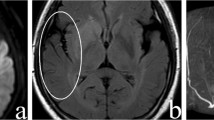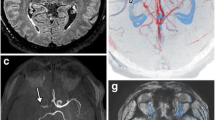Abstract
Objectives
To evaluate the utility of BLADE fluid-attenuated inversion recovery images (FLAIR) magnetic resonance (MR) imaging compared to conventional FLAIR for the detection of arterial hyperintensity (AH) in hyperacute territorial infarction.
Methods
We retrospectively analysed MR images of patients with hyperacute (<6 h) territorial infarction over a 9-month study period. Special attention was paid to the presence or absence of AH in the frontal, parietal and temporal lobes and the number of AHs in the sylvian fissure. We also evaluated the presence of three kinds of artefacts on BLADE FLAIR and conventional FLAIR images.
Results
AH was seen in 41 (91 %) patients with conventional FLAIR and 45 (100 %) patients with BLADE FLAIR images. More instances of AH were detected in the frontal, parietal and temporal lobes and within the sylvian fissure using BLADE FLAIR. Motion artefacts, pulsation artefacts from the sigmoid sinus and incomplete cerebrospinal fluid (CSF) nulling that reduced image quality were observed more frequently on conventional FLAIR images than on BLADE FLAIR images.
Conclusions
BLADE FLAIR sequences are more sensitive than conventional FLAIR for the detection of AH in hyperacute territorial infarctions and provide better image quality by reducing artefacts. They may be used in place of conventional FLAIR for patients with hyperacute stroke.
Key points
• Arterial hyperintensity is an important sign in patients with acute territorial infarctions.
• BLADE FLAIR sequences are sensitive for the detection of AH.
• BLADE FLAIR sequences provide better image quality by reducing artefacts.




Similar content being viewed by others
Abbreviations
- ADC:
-
apparent diffusion coefficient
- AH:
-
arterial hyperintensity
- BW:
-
bandwidth
- CSF:
-
cerebrospinal fluid
- DSA:
-
digital subtraction angiography
- DWI:
-
diffusion-weighted image
- ETL:
-
echo-training length
- FOV:
-
field of view
- FLAIR:
-
fluid-attenuated inversion recovery
- ICA:
-
internal carotid artery
- MCA:
-
middle cerebral artery
- MRI:
-
magnetic resonance imaging
- PACS:
-
picture-archiving and communication system
- PROPELLER:
-
periodically rotated overlapping parallel lines with enhanced reconstruction
- TE:
-
echo time
- TOF:
-
time-of-flight
- TR:
-
repetition time
- TSE:
-
turbo spin-echo
References
Pérez de la Ossa N, Hernández-Pérez M, Domènech S, Cuadras P, Massuet A, Millan M, Gomis M, López-Cancio E, Dorado L, Dávalos A (2012) Hyperintensity of distal vessels on flair is associated with slow progression of the infarction in acute ischemic stroke. Cerebrovasc Dis 34:376–384
Martin Ebinger AK, Galinovic I, Brunecker P, Malzahn U, Nolte CH, Endres M, Fiebach JB (2012) Fluid-attenuated inversion recovery images and stroke outcome after thrombolysis. Stroke 43:539–542
Sanossian N, Saver JL, Alger JR, Kim D, Duckwiler GR, Jahan R, Vinuela F, Ovbiagele B, Liebeskind DS (2009) Angiography reveals that fluid-attenuated inversion recovery vascular hyperintensities are due to slow flow, not thrombus. AJNR 30:564–568
Kobayashi J, Uehara T, Toyoda K, Endo E, Ohara T, Fujinami J, Nagatsuka K, Minematsu K (2013) Clinical significance of fluid-attenuated inversion recovery vascular hyperintensities in transient ischemic attack. Stroke 44:1635–1640
Haussen DC, Koch S, Saraf-Lavi E, Shang T, Dharmadhikari S, Yavagal DR (2013) FLAIR distal hyperintense vessels as a marker of perfusion-diffusion mismatch in acute stroke. J Neuroimaging 23:397–400
Lavdas E, Mavroidis P, Kostopoulos S, Glotsos D, Roka V, Koutsiaris AG, Batsikas G, Sakkas GK, Tsagkalis A, Notaras I, Stathakis S, Papanikolaou N, Vassiou K (2013) Elimination of motion, pulsatile flow and cross-talk artifacts using blade sequences in lumbar spine MR imaging. Magn Reson Imaging 31:882–890
Ohgiya Y, Suyama J, Seino N, Takaya S, Kawahara M, Saiki M, Sai S, Hirose M, Gokan T (2010) MRI of the neck at 3 tesla using the periodically ratated overlapping parallel lines with enhanced reconstruction (PROPELLER) (BLADE) sequence compared with T2-weighted fast spin-echo sequence. J Magn Reson Imaging 32:1061–1067
Forbes KP, Pipe JG, Karis JP, Heiserman JE (2002) Improved image quality and detection of acute cerebral infarction with PROPELLER diffusion-weighted MR imaging. Radiology 225:551–555
Pipe JG (1999) Motion correction with PROPELLER MRI: application to head motion and free-breathing cardiac imaging. Magn Reson Med 42:963–969
Lavdas E, Mavroidis P, Kostopoulos S et al (2013) Elimination of motion, pulsatile flow and cross-talk artifacts using blade sequences in lumbar spine MR imaging. Magn Reson Imaging 31:882–890
Naganawa S, Satake H, Iwano S, Kawai H, Kubota S, Komada T, Kawamura M, Sakurai Y, Fukatsu H (2008) Contrast-enhanced MR imaging of the brain using T1-weighted FLAIR with BLADE compared with a conventional spin-echo sequence. Eur Radiol 18:337–342
von Kalle T, Blank B, Fabig-Moritz C, Müller-Abt P, Zieger M, Wohlfarth K, Winkler P (2009) Reduced artifacts and improved assessment of hyperintense brain lesions with blade MR imaging in patients with neurofibromatosis type 1. Pediatr Radiol 39:1216–1222
Adams HP Jr, Bendixen BH, Kappelle LJ et al (1993) Classification of subtype of acute ischemic stroke. Definitions for use in a multicenter clinical trial. TOAST. Trial of Org 10172 in Acute Stroke Treatment. Stroke 24:35–41
Lavdas E, Mavroidis P, Hatzigeorgiou V, Roka V, Arikidis N, Oikonomou G, Andrianopoulos K, Notaras I (2012) Elimination of motion and pulsation artifacts using BLADE sequences in knee MR imaging. Magn Reson Imaging 30:1099–1110
Hirokawa Y, Isoda H, Maetani YS, Arizono S, Shimada K, Togashi K (2008) Evaluation of motion correction effect and image quality with the periodically rotated overlapping parallel lines with enhanced reconstruction (PROPELLER) (BLADE) and parallel imaging acquisition technique in the upper abdomen. J Magn Reson Imaging 28:957–962
Arena L, Morehouse HT, Safii J (1995) MR imaging artifacts that simulate disease: how to recognize and eliminate them. Radiographics 15:1373–1394
Acknowledgements
The scientific guarantor of this publication is Soo Mee Lim, M.D., Department of Radiology, Mokdong Hospital, Ewha Womans University School of Medicine. The authors of this manuscript declare no relationships with any companies whose products or services may be related to the subject matter of the article. This study has received funding by the Basic Science Research Program through the National Research Foundation of Korea (NRF) funded by the Ministry of Education Science and Technology (2012R1A2A2A01013169) and Ewha Womans University Global Top 5 Project Research Grant of 2012. No complex statistical methods were necessary for this paper. Institutional review board approval and written informed consent were not required because this study is a retrospective analysis of brain MRI, obtained for clinical purposes. Methodology: retrospective, observational study, performed at one institution.
Author information
Authors and Affiliations
Corresponding author
Rights and permissions
About this article
Cite this article
Kwag, E., Lim, S.M., Park, J.E. et al. Arterial hyperintensity on BLADE fluid-attenuated inversion recovery images (FLAIR) in hyperacute territorial infarction: comparison with conventional FLAIR. Eur Radiol 24, 2045–2051 (2014). https://doi.org/10.1007/s00330-014-3210-1
Received:
Revised:
Accepted:
Published:
Issue Date:
DOI: https://doi.org/10.1007/s00330-014-3210-1




